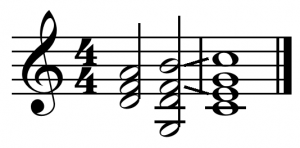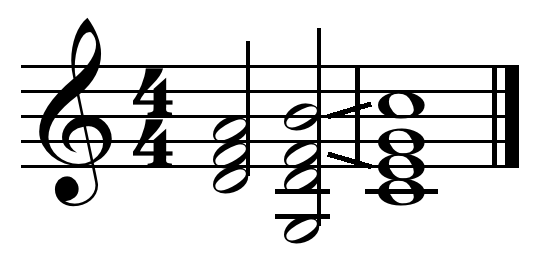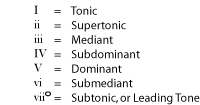Harmonic cadences and tonal music
A cadence is a place in a piece of music that feels like a stopping or resting point. In tonal music, cadences are classified by their chord progressions.
A cadence is any place in a piece of music that has the feel of an ending. This can be either a strong, definite stopping point – the end of the piece, for example, or of a movement, or section – but it also refers to the “temporary-resting-place” pauses that come at the ends of individual phrases.
A piece of music can come to an end by simply stopping, of course, but when it does that, most listeners will react with dissatisfaction: the music simply “stopped” instead of “ending” properly. A more satisfying ending is usually provided by giving clues in the music (in the progression of chords, for example, or the number and length of the phrases) that signal to the listener that the end is coming up.

Like the ending of a story (or a sentence, paragraph or chapter in the story), an ending in music makes sense if it follows certain customs that the listener expects to hear. And like the customs for storytelling, these expectations can be different in different musical traditions.
Some things that produce a feeling of cadence
In most Western and Western-influenced music (including jazz and “world” musics), harmony is by far the most important signal of cadence.
Harmony
– The most fundamental “rule” of the major-minor harmony system is that music ends on the tonic. A tonal piece of music will almost certainly end on the tonic, although individual phrases or sections may end on a different chord (the dominant is a popular choice). But again, you cannot just throw in a tonic chord and expect it to sound like an ending; the music must “lead up to” the ending and make it feel inevitable (just as a good story makes the ending feel inevitable, even if it’s a surprise). So the term cadence, in tonal music, usually refers to the ending chord plus the chord or two immediately before it that led up to it. There are lots of different terms for the most common tonal cadences; you will find the most common terms below. Some (but not all) modal musics also use harmony to indicate cadence.
Melody
– In the major/minor tradition, the melody will normally end on some note of the tonic chord triad, and a melody ending on the tonic will give a stronger (more final-sounding) cadence than one ending on the third or fifth of the chord. In some modal musics, the melody plays the most important role in the cadence. Like a scale, each mode also has a home note, where the melody is expected to end. A mode often also has a formula that the melody usually uses to arrive at the ending note. For example, it may be typical of one mode to go to the final note from the note one whole tone below it; whereas in another mode the penultimate note may be a minor third above the final note. (Or a mode may have more than one possible melodic cadence, or its typical cadence may be more complex.)
Rhythm
– Changes in the rhythm, a break or pause in the rhythm, or a slowing of or pause in the harmonic rhythm are also often found at a cadence.
Form
– Since cadences mark off phrases and sections, form and cadence are very closely connected, and the overall architecture of a piece of music will often indicate where the next cadence is going to be – every eight measures for a certain type of dance, for example. (When you listen to a piece of music, you actually expect and listen for these regularly-spaced cadences, at least subconsciously.)
Harmony and chord progressions in Western music are complex subjects that can take up entire college music theory courses. Complicating matters is the fact that there are several competing systems for naming cadences. I’m not going to go into the theory here or even the naming systems. For those who are looking for definitions of the most common terms used when referring to cadences, here is a list. Unfortunately, the various naming systems may use the same terms to mean different things, so even a list of basic terms is a bit confusing.
Music Texture
– Changes in the texture of the music also often accompany a cadence. For example, the music may momentarily switch from harmony to unison or from counterpoint to a simpler block-chord homophony.
Some tonal musiccadence terms
Here are the most important music cadences of Western music
Authentic
– A dominant chord followed by a tonic chord (V-I, or often V7-I).
Complete Cadence
– same as an authentic cadence.
Deceptive Cadence
– This refers to any time that the music seems to lead up to a cadence, but then doesn’t actually land on the expected tonic, and also often does not bring the expected pause in the music.
False Cadence
– Same as a deceptive cadence.
Half-cadence
– May mean a cadence that ends on the dominant chord (V). This type of cadence is more common at pause-type cadences than at full-stop ones. OR may refer to a plagal cadence.
Half close
– Same as a plagal cadence.
Imperfect Cadence
– May mean an authentic (V-I) cadence in which the chord is not in root position, or the melody does not end on the tonic. OR may mean a cadence that ends on the dominant chord (see “half-cadence”).
Interrupted Cadence
– Same as a false cadence.
Perfect Cadence
– Same as an authentic cadence. As its name suggests, this is considered the strongest, most final-sounding cadence. Some do not consider a cadence to be completely perfect unless the melody ends on the tonic and both chords are in root position. Plagal Cadence – A subdominant chord followed by a tonic chord (IV-I). For many people, this cadence will be familiar as the “Amen” chords at the end of many traditional hymns.
Semi-cadence
– Same as a half-cadence. You can listen to a few simple cadences here: Perfect Cadence, Plagal Cadence, Half Cadence, Deceptive Cadence. The figure below also shows some very simple forms of some common cadences. The first step in becoming comfortable with cadences is to start identifying them in music that is very familiar to you. Find the pauses and stops in the music. Do a harmonic analysis of the last few chords before each stop, and identify what type of cadence it is. Then see if you can begin to recognize the type of cadence just by listening to the music.
Examples of Common Cadences
- Perfect Cadence in C major

- Plagal Cadence in C major

- Deceptive Cadence in C major





